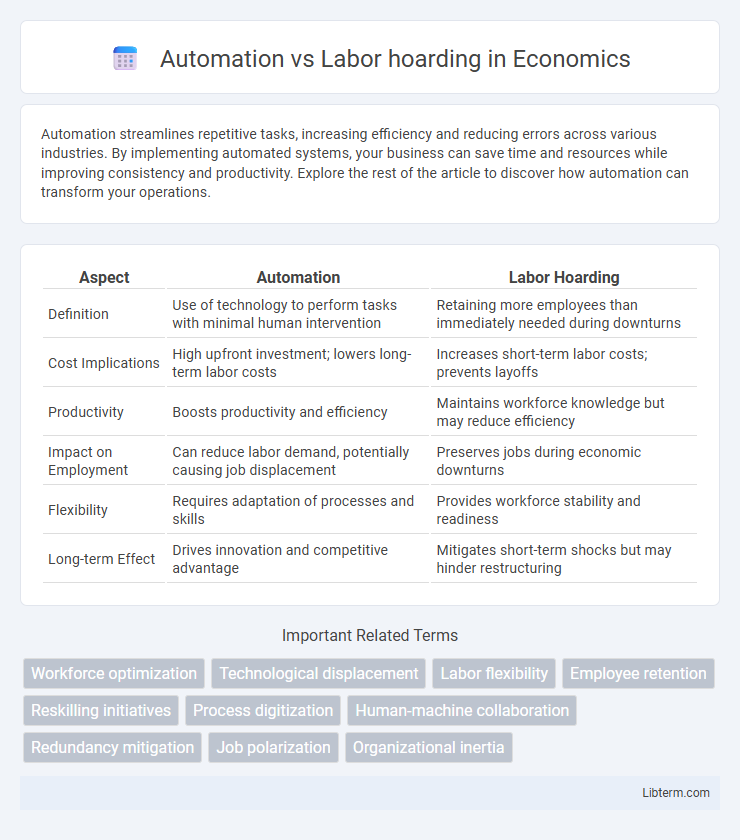Automation streamlines repetitive tasks, increasing efficiency and reducing errors across various industries. By implementing automated systems, your business can save time and resources while improving consistency and productivity. Explore the rest of the article to discover how automation can transform your operations.
Table of Comparison
| Aspect | Automation | Labor Hoarding |
|---|---|---|
| Definition | Use of technology to perform tasks with minimal human intervention | Retaining more employees than immediately needed during downturns |
| Cost Implications | High upfront investment; lowers long-term labor costs | Increases short-term labor costs; prevents layoffs |
| Productivity | Boosts productivity and efficiency | Maintains workforce knowledge but may reduce efficiency |
| Impact on Employment | Can reduce labor demand, potentially causing job displacement | Preserves jobs during economic downturns |
| Flexibility | Requires adaptation of processes and skills | Provides workforce stability and readiness |
| Long-term Effect | Drives innovation and competitive advantage | Mitigates short-term shocks but may hinder restructuring |
Understanding Automation: Definition and Key Concepts
Automation involves the use of technology to perform tasks traditionally done by human labor, aiming to increase efficiency and reduce operational costs. Key concepts include robotics, artificial intelligence, and process optimization, which collectively enable machines to execute repetitive or complex functions with minimal human intervention. Understanding automation requires analyzing its impact on labor demand, as it can lead to labor displacement or labor hoarding, where firms retain excess workers despite automation advancements.
What is Labor Hoarding? An Overview
Labor hoarding refers to the practice where firms retain excess workers during periods of reduced demand instead of laying them off. This strategy preserves employee skills and morale, reducing future recruitment and training costs when demand rebounds. While labor hoarding can lead to short-term inefficiencies, it often supports long-term productivity and organizational resilience.
Historical Context: Automation vs Labor Hoarding
The historical context of automation versus labor hoarding illustrates a dynamic tension in industrial and economic development, where firms historically balanced investment in mechanization with retaining excess workforce during downturns to minimize rehiring costs. The Industrial Revolution marked the beginning of automation, reducing reliance on manual labor, yet labor hoarding persisted as a strategy during economic fluctuations, preserving skilled workers despite reduced demand. Over time, advances in technology and changing labor market conditions shifted this balance, with automation increasingly replacing labor hoarding as firms prioritize efficiency and adaptability.
Economic Drivers of Automation Adoption
Economic drivers of automation adoption include rising labor costs, the need for increased operational efficiency, and competitive pressure to innovate. Automation reduces dependency on manual labor, enabling firms to scale production while minimizing wage-related expenses and mitigating labor shortages. Investment in advanced technologies often correlates with higher productivity gains and long-term cost savings, prompting businesses to prioritize automation over labor hoarding.
Motivations Behind Labor Hoarding Strategies
Labor hoarding strategies are primarily motivated by firms' desire to preserve human capital and avoid future recruiting and training costs, especially during economic downturns. Companies anticipate potential demand rebounds, maintaining workforce levels to ensure operational readiness and retain experienced employees. This approach mitigates risks associated with layoffs, such as loss of firm-specific knowledge and diminished employee morale, supporting long-term productivity despite short-term inefficiencies.
Impact on Workforce Productivity
Automation enhances workforce productivity by streamlining repetitive tasks, reducing human error, and enabling faster output across industries. Labor hoarding, characterized by retaining more employees than immediately necessary, can lead to underutilized labor and decreased efficiency, ultimately increasing operational costs without proportional output gains. Balancing automation with strategic labor retention optimizes workflow, maintains institutional knowledge, and supports sustainable productivity growth.
Effects on Company Costs and Profitability
Automation reduces labor costs by enhancing efficiency and minimizing human error, significantly lowering operational expenses and increasing profit margins. Labor hoarding, while maintaining workforce levels during downturns, elevates fixed costs and reduces flexibility, potentially impeding profitability. Companies balancing automation investments against labor retention must evaluate long-term cost savings versus the risks of excessive wage expenses and underutilized staff.
Social and Ethical Implications
Automation reduces repetitive tasks, potentially displacing workers and exacerbating income inequality, while labor hoarding maintains employment but may limit technological progress and firm competitiveness. Socially, labor hoarding can preserve worker dignity and community stability, yet risks inefficiency and higher operational costs. Ethically, balancing automation and labor hoarding requires addressing fair employment opportunities, worker retraining, and equitable distribution of productivity gains.
Future Trends: Balancing Automation and Labor Retention
Future trends in balancing automation and labor retention emphasize integrating advanced technologies with human skills to maximize productivity while preserving employment. Companies increasingly adopt hybrid models combining robotic process automation (RPA) and upskilling programs to mitigate labor hoarding effects. Strategic workforce planning leverages AI-driven analytics to forecast labor needs, ensuring optimal alignment between automation deployment and human capital management.
Strategic Recommendations for Businesses
Businesses should invest in advanced automation technologies to enhance productivity while carefully assessing labor needs to avoid costly labor hoarding. Implementing workforce analytics can provide data-driven insights, enabling strategic workforce planning that aligns labor capacity with operational demands. Prioritizing flexible workforce models and ongoing employee upskilling ensures adaptability and sustained competitive advantage in evolving market conditions.
Automation Infographic

 libterm.com
libterm.com